Scythe sees you controlling factions in fictional 1920’s Europe
Original Review: December 4th, 2023, post updated with Giveaway (at foot of article) November 21st, 2023.
About five years ago, it was hard to tell which “gamer’s game” was top of the tree. Lords of Waterdeep, Five Tribes, Viticulture and Dead of Winter were just a few of the games making their case, but there was no clear winner. Enter Jamey Stegmaier’s Scythe — perhaps the first “incredible” Kickstarter success in board games, and certainly, the modern board game against which all others would be measured for at least the next two to three years.
It’s difficult to summarise Scythe’s gameplay in a single sentence, which is perhaps part of what adds to its appeal. It’s a game that features up to seven players, each controlling a unique and asymmetrical faction in the fictionalised, alternative 1920’s Europe of artist Jakub Różalski. Those players will lead their faction through a series of turns by collecting resources, expanding across a map, building infrastructure and perhaps — but not always — by engaging in conflict.
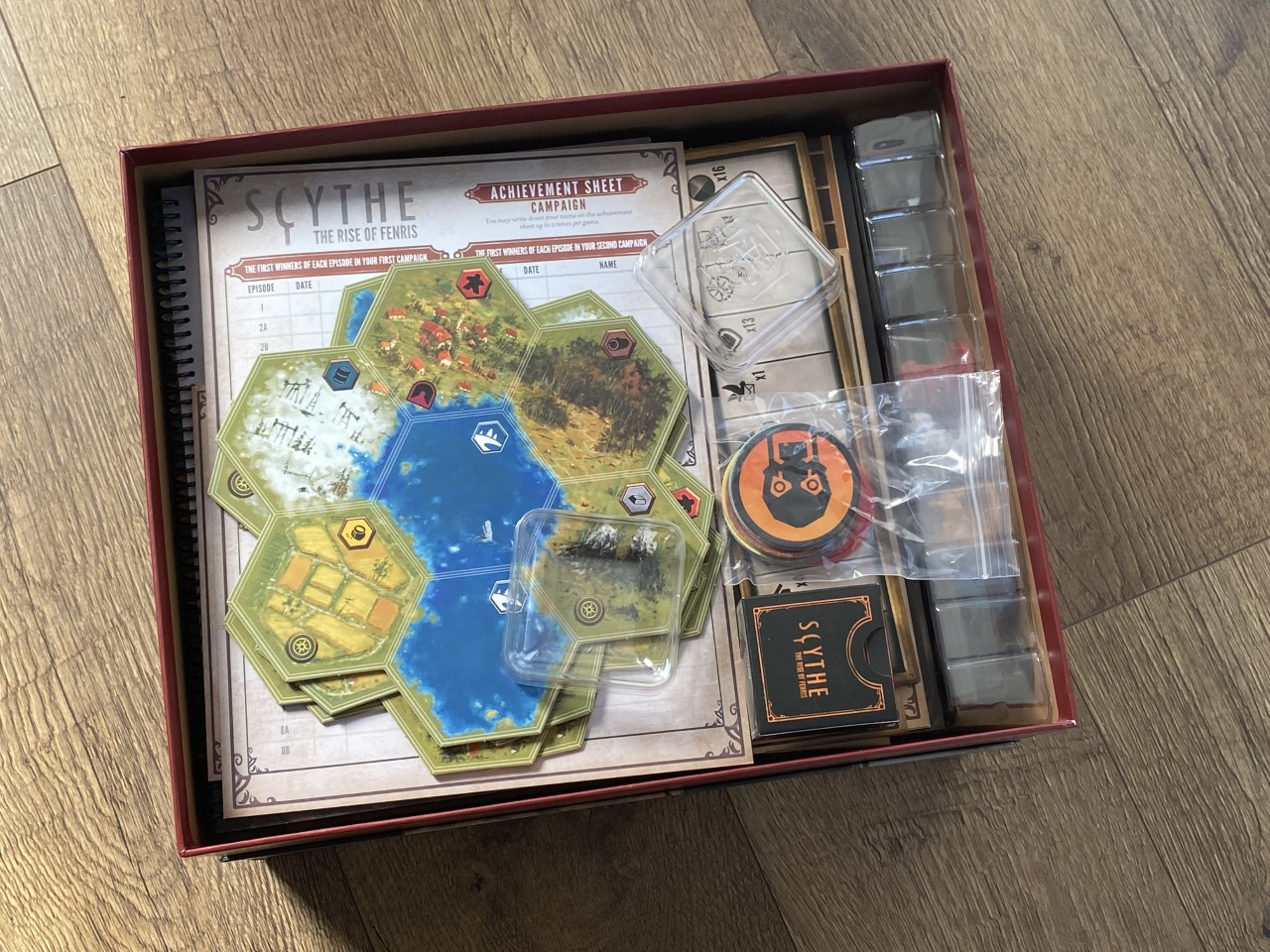
Just to touch on that last point in a bit more depth, Scythe is perhaps one of the best examples in gaming of how to create conflict without actually having to force the players to fight. It is, in effect, an exceptional cold war simulator, wherein players certainly may decide to fight each other, but due to the resource cost versus the opportunity gained for winning, fights are generally few and far between.
Instead, Scythe offers players a more cerebral route to victory — with about eight or nine different ways to score victory points, and the end game being triggered on the turn where any one player reaches five points in total. Completing an objective, reaching maximum power or popularity, or reaching the central board tile all offer ways to score a point — and yes, so does winning a battle.
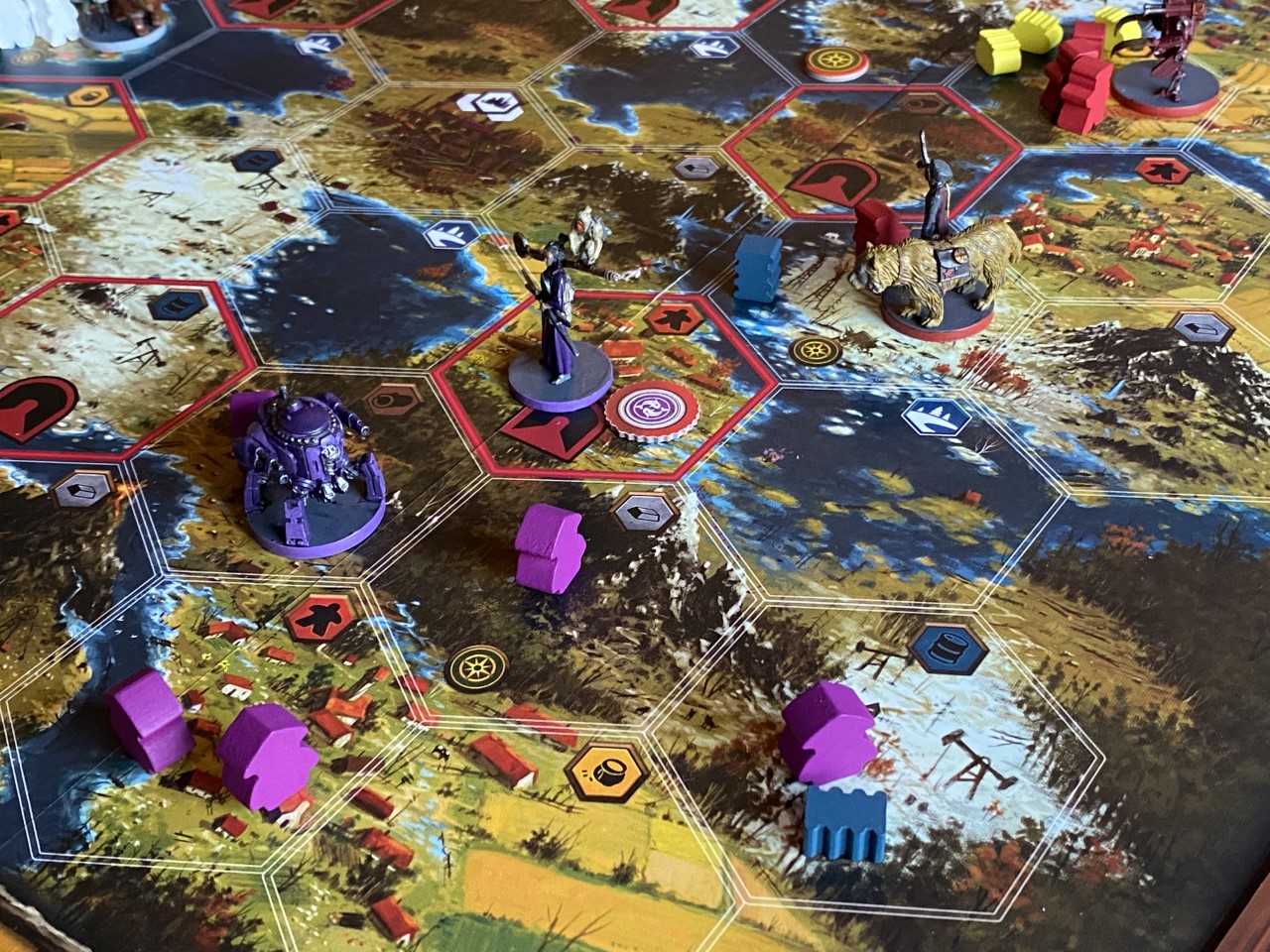
In order to achieve some of these objectives, players need to increase their infrastructure. This is done by expanding on the board using their character (who can fight, or claim encounter tokens), their mechs (who can fight, but must be built before use) or their lowly worker meeples. These latter pieces (made from wood, rather than plastic like the characters and mechs) are the backbone of your nation, and they are the only unit that can generate the resources that are shown on the map: workers, food, oil, metal and wood.
Interestingly, and perhaps even uniquely at the time of its release, resources in Scythe are only controlled by a player when that player has a unit (character, mech or worker) in the same space. Resources can be transported as units move and spent whenever they are controlled in this way, but if you move a unit and leave the resources behind, then you no longer control them. Similarly, if you leave a space and haven’t got a unit or building (which I’ll mention later) in it, then you will no longer control it (for scoring, generating resources, or any other reason.)
Having mentioned building infrastructure, generating resources and creating mechs, I should talk about another interesting aspect of Scythe. Each nation has a set player board and starting location, but during setup, a slightly randomised action board is added. Each board shows the same four “top actions” across its upper half, but the “bottom actions” that accompany them on the lower half of each board will differ, both in placement and cost or benefit.
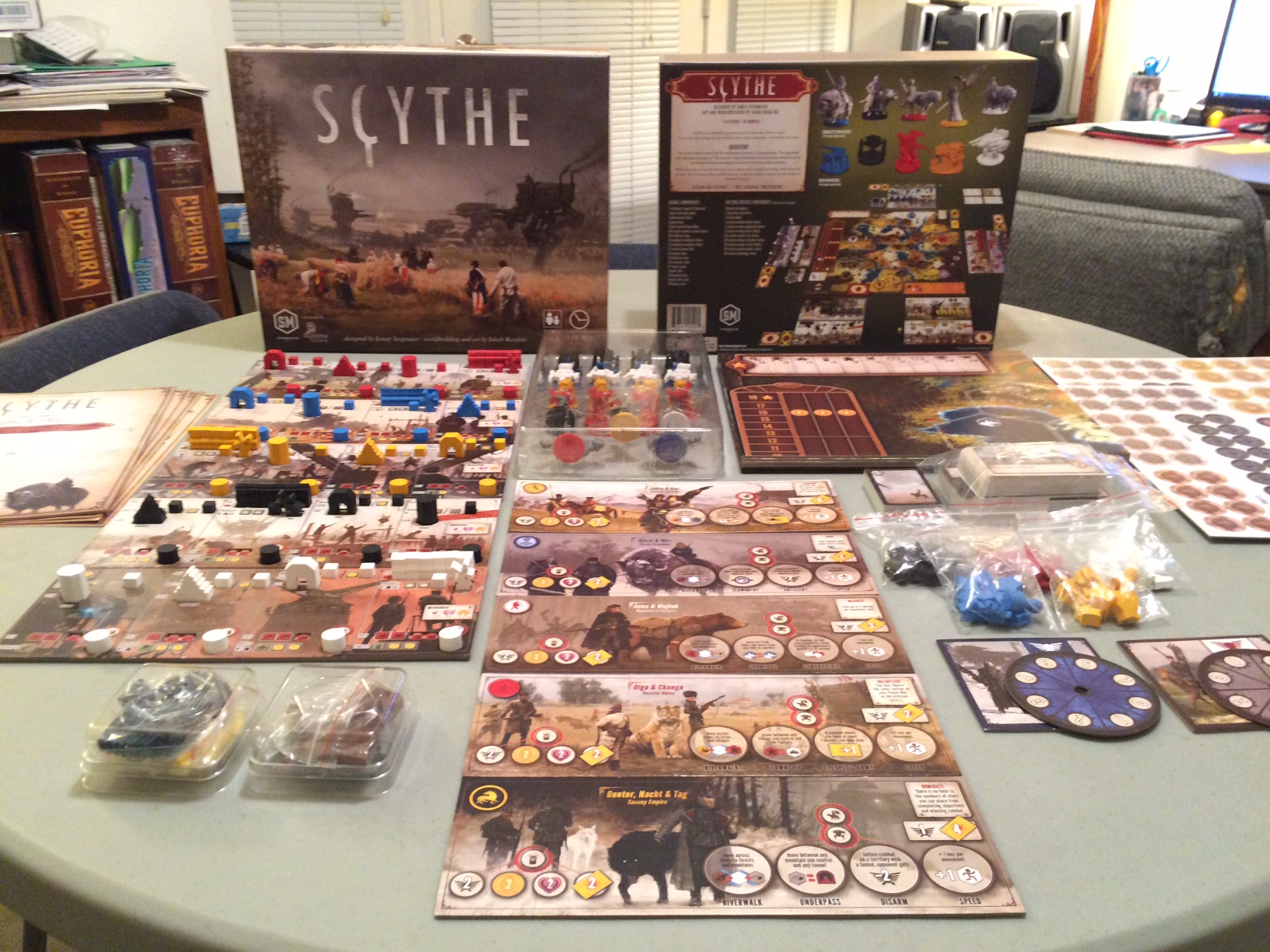
These boards are double-thickness (again, Scythe was one of the first games to adopt this style) which means that wooden pieces can slot into spaces and remain correctly aligned even if the table or board is knocked. Each game begins with a number of upgrade tokens (two kinds) across the top, a selection of worker meeples to recruit, and then a handful of buildings. Meanwhile on their nation board, each player has four mechs that cover mech abilities, meaning that both the mech itself and the ability underneath are unlocked as and when a mech enters play.
If all of this resource and board management sounds complex, it is — and perhaps another thing that is much loved about Scythe is that it was a game that both dared to combine heavily consumer focussed production (great art, miniatures, superb component quality etc) with more complex mechanical concepts. Rarely before Scythe had so many “casual” gamers experienced a game of such depth and complexity.
Such was Scythe’s popularity that it spawned not only a complete spin off (My Little Scythe) but a series of expansions that add further nuance to the gameplay. Thankfully, most of these expansions make relatively minor changes, and as a result they are fairly easy to incorporate.

Invaders from Afar
Invaders from Afar was Scythe’s first expansion, and whilst I can’t recall if it was foretold as part of the Kickstarter or not, it was a done deal right from the first printing — because there are two player starting locations on the board that weren’t in the base game. These new playable factions — styled on the Scottish and the Japanese — introduce complex elements mainly aimed at more experienced players.
The Albion clan, for example, can place banners to double the value of territory they hold (for the purpose of end game scoring), whilst the Kagawa clan can place traps on the board, then use them to teleport their character and mechs around the place. Both of these clans have some interesting mech abilities as well, giving them unusual incentives for attacking, defending or even feinting.
There’s not much else inside the Invaders from Afar box, but two new factions is enough really, isn’t it? There are some new automa cards to use these factions solo, and there’s also a handful of tokens — some fifty denomination money tokens, a token that amends one of the original factions and a brief instruction manual. Overall, this is very much a “more of the same” expansion, but it feels pretty essential to me, given that the Albion and Kagawa faction starting locations are printed on the base game board.
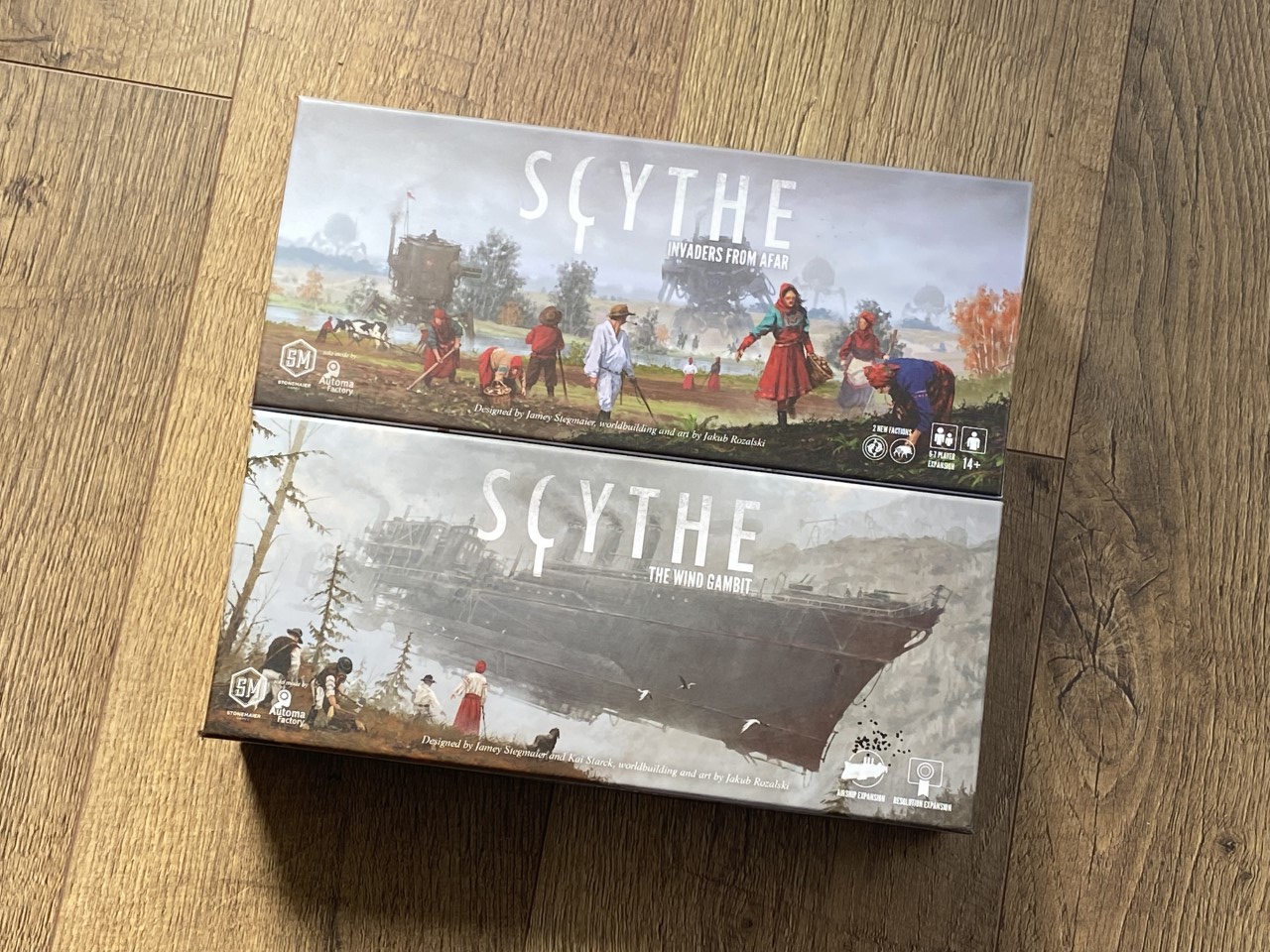
The Wind Gambit
In this second expansion, which is also “more of the same” Jamey Stegmaier and team expand upon the consumer appeal of the game with seven (one for each faction, including those from Invaders from Afar) huge plastic airships. As well as looking impressive, these flying behemoths come with variable capabilities for movement, resource or meeple transportation and combat which are determined by a passive and an aggressive card drawn during setup.
In addition, The Wind Gambit also comes with a set of resolution cards which change the end game trigger. If you recall earlier, I mentioned that the game end will trigger exactly when one player achieves their sixth star — well with resolutions in play, the end game trigger is varied to something like “when this happens” or “when that happens.”
Honestly, I think The Wind Gambit is OK, but the airships feel pretty restrained to me. For their size — about that of three mechs — they just end up feeling a bit like glorified transport vehicles. There are some exceptions based on the cards you draw — like the ability to rapidly expand across water and potentially take over the tiles behind another player’s main forces, however this is quite an edge case.

Encounters
In this small box expansion, the only addition is a fairly sizable pile of additional encounter cards. Continuing the theme of the cards in the original game, these cards include a number of interesting and amusing scenarios for the players to read aloud during play, many of which were written by fans of Scythe. You can play with these new cards exclusively, some of them, or just shuffle the whole lot into your original deck — the result is more variety, but not a game changer.
The Rise of Fenris
Now we are talking — this is one heck of a content drop. The Rise of Fenris is presented as a campaign expansion complete with a huge binder outlining the story, the setup for each game and which boxes to open. The Rise of Fenris is not a legacy expansion however, and nothing is destroyed or permanently changed, it’s more just that the game presents the content bit by bit – enticing you with a little more in each game.
I won’t spoil the content here, but I will say that The Rise of Fenris includes more overall than Invaders from Afar and The Wind Gambit both together. It’s really difficult to justify that statement without actually explaining what’s behind it, but what I will say is that there are changes to almost every part of Scythe, offered as optional modules, and none of the included content is bad.

The Legendary Box
I have to say, this is a first for me — a review for a box. The Scythe Legendary Box is, well, big. Very big. That said, despite its size, I think legendary might be pushing it a bit. You see normally, a large box used to store a game and all its expansions would be complete with a guide as to how to do so, perhaps even an insert to help organise things.
The Legendary Box contains three tuck boxes that you can (and I did) use, but which are hardly specific to the purpose. You’ll need to discard your box for the base game and all expansions, and then you just kind of ram stuff into the so-called Legendary Box. In the end, it looks decent on the shelf and it does the job, but it’s disappointing compared to offerings from third parties on similarly large, expansive games.
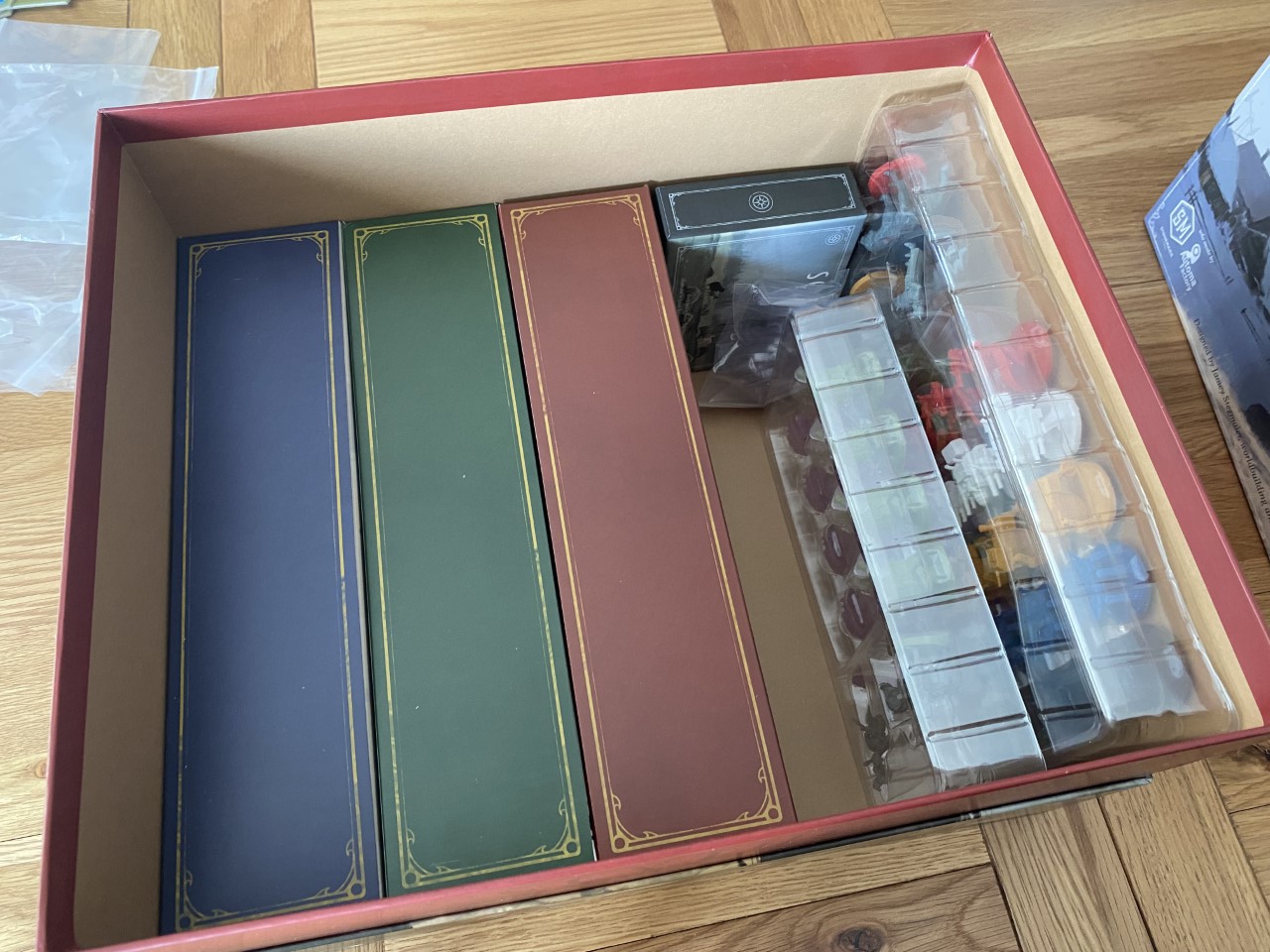
Conclusion
There is, without doubt, more stuff available for Scythe. There are metal coins and realistic resources available, and there is a modular board that allows players to adjust starting positions, resource locations and even bonus objectives. There’s even a board expansion that simply sits alongside the standard board (when turned over) and offers larger spaces, which is handy because the spaces can get crowded with mechs, workers, resources and airships etc.
When I started preparing for this review, I hadn’t played Scythe for maybe two years, and I was curious about whether the gameplay would still stand up to scrutiny. In all fairness, it was, and is, a fantastic and very unique design — the movement of resources and the lack of combat in such a confrontational game remain very unusual. The quality of the components does wonders too, even if those airships and additional mechs are largely set dressing.

If you’re not afraid of a more intelligent and occasionally brain-burning take on area control, then Scythe is probably a game you should check out. If, on the other hand, you already have it and it’s been sitting dormant for a few years, then I would recommend you pick up The Rise of Fenris and see if it can’t inject a bit of life into the old box.
You can pick up a copy of Scythe at almost any friendly local game store, or if you’d like to buy it online, you can do so at 365 Games.
Love board games? Check out our list of the top board games we’ve reviewed.
I’m particularly interested in the amusing scenarios on offer.
Something for all levels of engagement ! I like the fact it will challenge me
This look really good fun and right up my street
The game seems unique I think it will be great fun
This is awesome so exciting
The tactical element looks fun!
The details of the characters and the different levels both have appeal.
It looks like it will tax my brain!
This game looks like you could really get drawn into it, fantastic and very interesting!
I used to have Scythe and it was awesome, only played twice though. Sold due to car issues. Would love to have it back!
I like how you can have different things happen in the game.
The tactical element
Love a game with meeples tbh
looks unique
i like that it looks like alot is going on